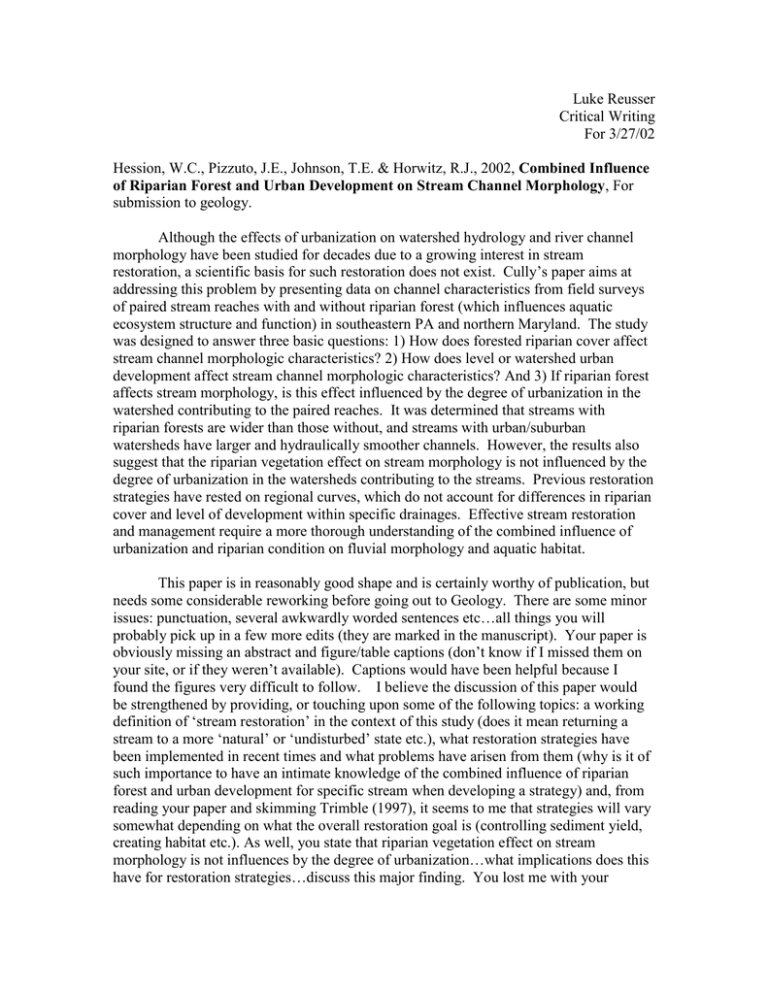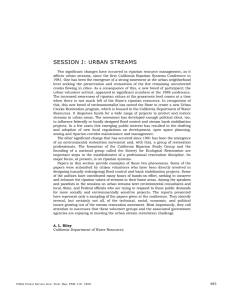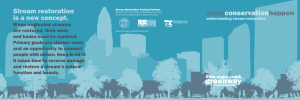Luke Reusser Critical Writing For 3/27/02
advertisement

Luke Reusser Critical Writing For 3/27/02 Hession, W.C., Pizzuto, J.E., Johnson, T.E. & Horwitz, R.J., 2002, Combined Influence of Riparian Forest and Urban Development on Stream Channel Morphology, For submission to geology. Although the effects of urbanization on watershed hydrology and river channel morphology have been studied for decades due to a growing interest in stream restoration, a scientific basis for such restoration does not exist. Cully’s paper aims at addressing this problem by presenting data on channel characteristics from field surveys of paired stream reaches with and without riparian forest (which influences aquatic ecosystem structure and function) in southeastern PA and northern Maryland. The study was designed to answer three basic questions: 1) How does forested riparian cover affect stream channel morphologic characteristics? 2) How does level or watershed urban development affect stream channel morphologic characteristics? And 3) If riparian forest affects stream morphology, is this effect influenced by the degree of urbanization in the watershed contributing to the paired reaches. It was determined that streams with riparian forests are wider than those without, and streams with urban/suburban watersheds have larger and hydraulically smoother channels. However, the results also suggest that the riparian vegetation effect on stream morphology is not influenced by the degree of urbanization in the watersheds contributing to the streams. Previous restoration strategies have rested on regional curves, which do not account for differences in riparian cover and level of development within specific drainages. Effective stream restoration and management require a more thorough understanding of the combined influence of urbanization and riparian condition on fluvial morphology and aquatic habitat. This paper is in reasonably good shape and is certainly worthy of publication, but needs some considerable reworking before going out to Geology. There are some minor issues: punctuation, several awkwardly worded sentences etc…all things you will probably pick up in a few more edits (they are marked in the manuscript). Your paper is obviously missing an abstract and figure/table captions (don’t know if I missed them on your site, or if they weren’t available). Captions would have been helpful because I found the figures very difficult to follow. I believe the discussion of this paper would be strengthened by providing, or touching upon some of the following topics: a working definition of ‘stream restoration’ in the context of this study (does it mean returning a stream to a more ‘natural’ or ‘undisturbed’ state etc.), what restoration strategies have been implemented in recent times and what problems have arisen from them (why is it of such importance to have an intimate knowledge of the combined influence of riparian forest and urban development for specific stream when developing a strategy) and, from reading your paper and skimming Trimble (1997), it seems to me that strategies will vary somewhat depending on what the overall restoration goal is (controlling sediment yield, creating habitat etc.). As well, you state that riparian vegetation effect on stream morphology is not influences by the degree of urbanization…what implications does this have for restoration strategies…discuss this major finding. You lost me with your stats…are they all necessary? One other thing; seeing as stream restoration is the catalyst for this paper, do you want to work that into your title somehow? Specific comments keyed to numbers in the manuscript: 0) Seeing as the motivation for this study is stream restoration, do you want to work that into your title somehow? 1) Habitat for what species…what kind of channel morphology is desirable for these species? 2) What exactly is the goal of ‘stream restoration’ in this context? What is the end goal. 3) Lead off the 2nd sentence of this paragraph with something other than ‘riparian forests’ which was used right above it. (ie-They are therefore…) 4) Does ‘paired’ me replicated? 5) If you are going to use statistical methods such as ANCOVA, and publishing this in geology, you have to tell us what the method is and how it works. 6) Similar to five…you lost me with this whole section. Clarify it if possible, if not get rid of it. 7) Rewrite sentence maybe…’However, only channel size and the implications this has on stream restoration practice will be presented in this paper.’ 8) What is meant by ‘natural gap?’ 9) What processes are being debated and what bearing to they have on this study and stream restoration strategies?’ 10) Explain these curves. 11) Rewrite these last two sentences. “Most of our watersheds are developed, currently under development pressure, or will be in the near future, and the ability to manage and restore streams and rivers depends on knowledge concerning the combined influence of watershed urbanization and riparian condition on fluvial morphology and aquatic habitat.






